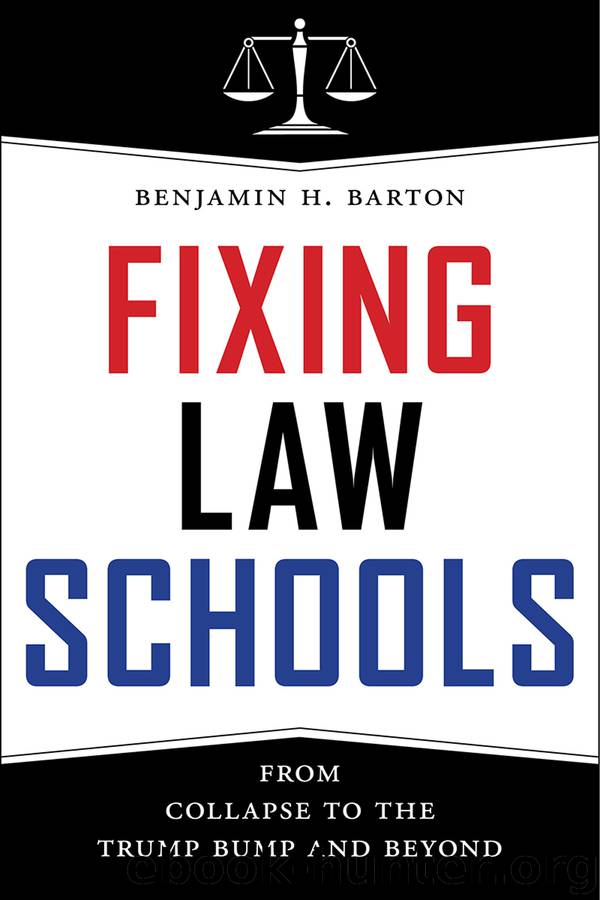Fixing Law Schools by Benjamin H. Barton

Author:Benjamin H. Barton
Language: eng
Format: epub
Publisher: NYU Press
7
WHY HAVEN’T MORE LAW SCHOOLS CLOSED?
PART 3: THE DOE
Phew! Struggling law schools have so far managed to pilot their way between Scylla and Charybdis, keeping the lights on through a series of aggressive cost-cutting and revenue-boosting measures, while at the same time maintaining American Bar Association (ABA) accreditation. From 2010 until 2016, even far-thinking strategists would have recognized only those two dangers: running out of money and losing ABA accreditation. In 2016, however, a third threat emerged. When the Department of Education (DOE) stripped the Charlotte School of Law of the ability to offer federal loans for spring semester 2017, a whole other avenue of danger opened, and one that apparently did not operate on the leisurely and forgiving pace of an ABA disaccreditation. We’ll spend some time unpacking the DOE and the Charlotte School of Law below. But the story actually starts earlier, with the Obama DOE’s lengthy battle against some parts of for-profit higher education.
SOME BACKGROUND ON THE OBAMA DOE AND FOR-PROFIT HIGHER ED
From 1998 until 2012, the for-profit segment of postsecondary education boomed, with more students, more profits, more campuses, and more government-backed debt.1 Stock prices soared, and the for-profit sector tried to keep the growth coming. If you are a football fan you may remember that in 2006 the Arizona Cardinals named their sparkling new Glendale, Arizona, facility “University of Phoenix Stadium.”2 If you are like me, you asked, “Wait, what’s Phoenix University? And how can it afford stadium naming rights?” Phoenix University was the flagship brand of the Apollo Group, a consortium of for-profit higher education brands/schools. At one point the Apollo Group traded at almost $90 a share and was successful enough to pay for naming rights to an NFL stadium. By 2017, Apollo traded at $10 a share and had been bought out by a private equity turnaround firm. It had also bailed on the naming rights agreement. The Cardinals’ stadium is now known as “State Farm Stadium,” a fitting coda to the rise and fall of the for-profit sector.3
There are two ways to describe the rise of the for-profit sector in the 2000s. The sunnier version argues that for-profit higher education boomed by offering innovative approaches to teaching and training, focusing on computerization, economies of scale, and new pedagogical approaches. This is certainly the story that these companies told as they grew.4
The harsher version argues that the growth was driven by aggressive advertising, fraudulent practices, and hoovering up federal student loans. Regulators accused these schools of misleading students about job prospects, the likelihood of graduation, the costs of attending, and the total debt load. Some schools paid recruiters bonuses depending on the number of students they enrolled, which led naturally to allegations of false promises and sharp tactics. Loan defaults ran much higher at for-profit schools than nonprofit schools.5
Eventually regulators started to take notice. In 2010, the US Government Accountability Office (GAO) released a scathing report alleging fraud and worse in recruiting and student loan applications at fifteen different for-profit institutions.6 In
Download
This site does not store any files on its server. We only index and link to content provided by other sites. Please contact the content providers to delete copyright contents if any and email us, we'll remove relevant links or contents immediately.
| Annotations & Citations | Law School Guides |
| Legal Profession | Legal Writing |
| Test Preparation |
Master of the Game by Sidney Sheldon(2209)
GRE Premier 2017 with 6 Practice Tests by Kaplan(1780)
Law School Essays that Made a Difference by Princeton Review(1739)
Law: A Very Short Introduction by Raymond Wacks(1660)
A Life of Crime by Harry Ognall(1618)
Objection! by Nancy Grace(1597)
Philosophy of law a very short introduction by Raymond Wacks(1577)
Examples & Explanations: Administrative Law by William F. Funk & Richard H. Seamon(1577)
College Essays that Made a Difference by Princeton Review(1575)
Writing to Win: The Legal Writer by Steven D. Stark(1516)
Cracking the SAT Premium Edition with 6 Practice Tests, 2017 by Princeton Review(1508)
GMAT For Dummies by Lisa Zimmer Hatch & Scott A. Hatch(1467)
Civil Procedure (Aspen Casebooks) by Stephen C. Yeazell(1462)
Sidney Sheldon (1982) Master Of The Game by Sidney Sheldon(1449)
Drafting Contracts: How and Why Lawyers Do What They Do, Second Edition by Stark Tina L(1428)
Storytelling for Lawyers by Meyer Philip(1381)
So You Want to be a Lawyer by Lisa Fairchild Jones Esq(1353)
Graduate Admissions Essays, Fourth Edition: Write Your Way into the Graduate School of Your Choice by Donald Asher(1332)
INDEFENSIBLE: One Lawyer's Journey Into the Inferno of American Justice by Feige David(1211)
